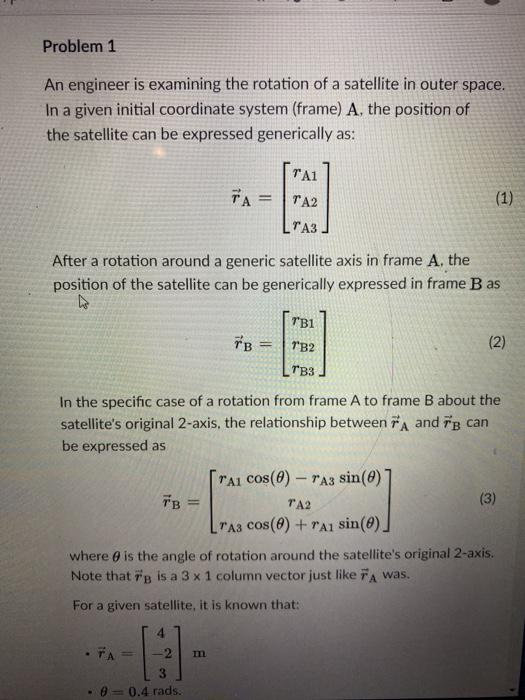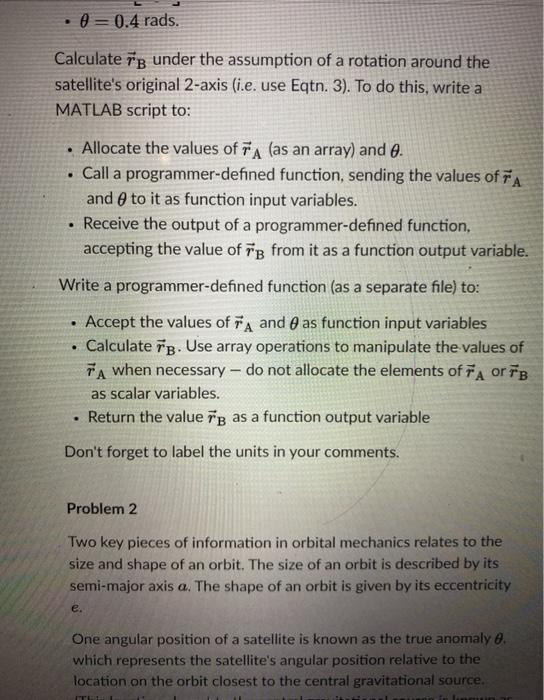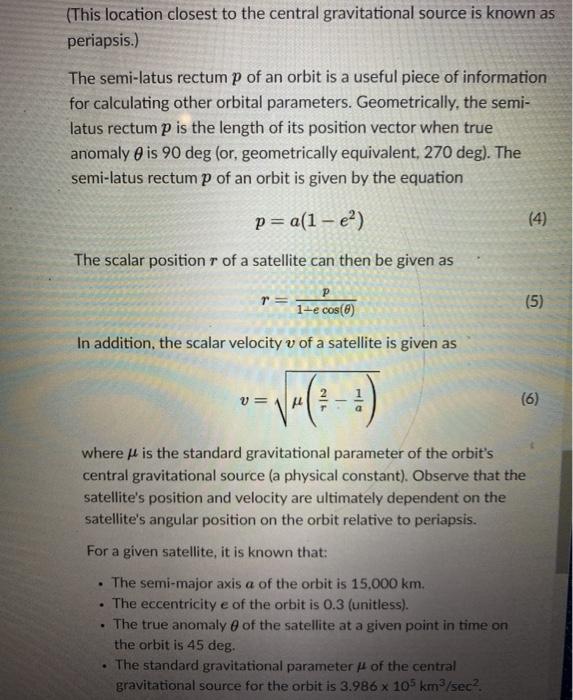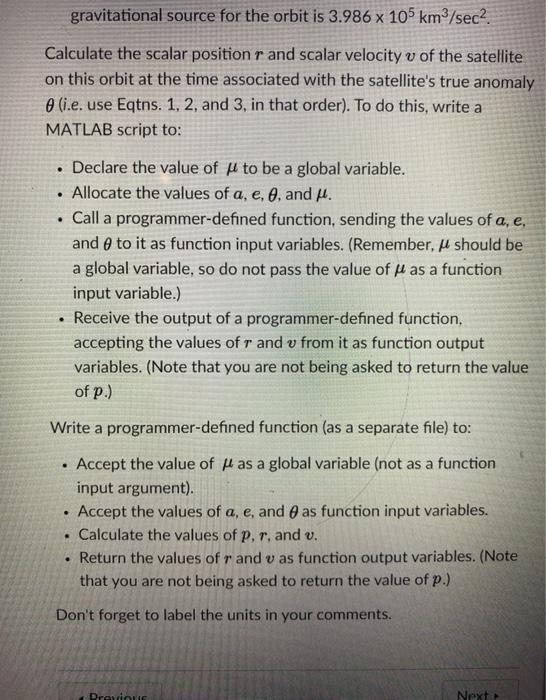Answered step by step
Verified Expert Solution
Question
1 Approved Answer
using MATLAB Problem 1 An engineer is examining the rotation of a satellite in outer space. In a given initial coordinate system (frame) A, the




using MATLAB
Problem 1 An engineer is examining the rotation of a satellite in outer space. In a given initial coordinate system (frame) A, the position of the satellite can be expressed generically as: TA1 TA = TA2 (1) LA3 After a rotation around a generic satellite axis in frame A, the position of the satellite can be generically expressed in frame B as TB1 TB 1'B2 (2) TB3 In the specific case of a rotation from frame A to frame B about the satellite's original 2-axis, the relationship between FA and B can be expressed as Tal cos(0) - A3 sin(0) TA2 (3) TA3 cos(6) + 'Al sin(0) where is the angle of rotation around the satellite's original 2-axis. Note that is is a 3 x 1 column vector just like FA was. ICO For a given satellite, it is known that: 4 3 8 = 0.4 rads. O=0.4 rads. Calculate FB under the assumption of a rotation around the satellite's original 2-axis (i.e. use Eqtn. 3). To do this, write a MATLAB script to: . Allocate the values of FA (as an array) and . Call a programmer-defined function, sending the values of FA and to it as function input variables. Receive the output of a programmer-defined function, accepting the value of FB from it as a function output variable. Write a programmer-defined function (as a separate file) to: . . Accept the values of FA and 6 as function input variables Calculate s. Use array operations to manipulate the values of FA when necessary do not allocate the elements of FA or TB as scalar variables. Return the value is as a function output variable Don't forget to label the units in your comments. Problem 2 Two key pieces of information in orbital mechanics relates to the size and shape of an orbit. The size of an orbit is described by its semi-major axis a. The shape of an orbit is given by its eccentricity e. One angular position of a satellite is known as the true anomaly 8. which represents the satellite's angular position relative to the location on the orbit closest to the central gravitational source. (This location closest to the central gravitational source is known as periapsis.) The semi-latus rectum p of an orbit is a useful piece of information for calculating other orbital parameters. Geometrically, the semi- latus rectum p is the length of its position vector when true anomaly is 90 deg (or, geometrically equivalent, 270 deg). The semi-latus rectum p of an orbit is given by the equation p=a(1 - e) The scalar position r of a satellite can then be given as r = 1+e cos(6) (5) In addition, the scalar velocity v of a satellite is given as v= CIL (6) where he is the standard gravitational parameter of the orbit's central gravitational source (a physical constant). Observe that the satellite's position and velocity are ultimately dependent on the satellites angular position on the orbit relative to periapsis. For a given satellite, it is known that: . The semi-major axis a of the orbit is 15.000 km. The eccentricity e of the orbit is 0.3 (unitless). The true anomaly e of the satellite at a given point in time on the orbit is 45 deg. The standard gravitational parameter of the central gravitational source for the orbit is 3.986 x 105 km/sec2 gravitational source for the orbit is 3.986 x 105 km/sec2. Calculate the scalar position r and scalar velocity v of the satellite on this orbit at the time associated with the satellite's true anomaly 0 (.e. use Eqtns. 1, 2, and 3, in that order). To do this, write a MATLAB script to: . . Declare the value of pi to be a global variable. Allocate the values of a, e, , and H. Call a programmer-defined function, sending the values of a, e, and e to it as function input variables. (Remember, i should be a global variable, so do not pass the value of pi as a function input variable.) Receive the output of a programmer-defined function, accepting the values of rand v from it as function output variables. (Note that you are not being asked to return the value of p.) . Write a programmer-defined function (as a separate file) to: Accept the value of pl as a global variable (not as a function input argument). Accept the values of a, e, and as function input variables. Calculate the values of p, r, and v. Return the values of rand v as function output variables. (Note that you are not being asked to return the value of p.) Don't forget to label the units in your comments. . Dress Next Step by Step Solution
There are 3 Steps involved in it
Step: 1

Get Instant Access to Expert-Tailored Solutions
See step-by-step solutions with expert insights and AI powered tools for academic success
Step: 2

Step: 3

Ace Your Homework with AI
Get the answers you need in no time with our AI-driven, step-by-step assistance
Get Started


